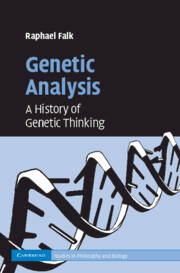Book contents
- Frontmatter
- Contents
- List of figures
- Acknowledgments
- Introduction
- PART I FROM REPRODUCTION AND GENERATION TO HEREDITY
- PART II FAKTOREN IN SEARCH OF MEANING
- PART III THE CHROMOSOME THEORY OF INHERITANCE
- PART IV GENES AS THE ATOMS OF HEREDITY
- PART V INCREASING RESOLVING POWER
- PART VI DEDUCING GENES FROM TRAITS, INDUCING TRAITS FROM GENES
- PART VII WHAT IS TRUE FOR E. COLI IS NOT TRUE FOR THE ELEPHANT
- 17 Extending hybridization to molecules
- 18 Overcoming the dogma
- 19 Dominance
- 20 Populations evolve, organisms develop
- Concluding comments
- Bibliography
- Index
19 - Dominance
Published online by Cambridge University Press: 07 August 2009
- Frontmatter
- Contents
- List of figures
- Acknowledgments
- Introduction
- PART I FROM REPRODUCTION AND GENERATION TO HEREDITY
- PART II FAKTOREN IN SEARCH OF MEANING
- PART III THE CHROMOSOME THEORY OF INHERITANCE
- PART IV GENES AS THE ATOMS OF HEREDITY
- PART V INCREASING RESOLVING POWER
- PART VI DEDUCING GENES FROM TRAITS, INDUCING TRAITS FROM GENES
- PART VII WHAT IS TRUE FOR E. COLI IS NOT TRUE FOR THE ELEPHANT
- 17 Extending hybridization to molecules
- 18 Overcoming the dogma
- 19 Dominance
- 20 Populations evolve, organisms develop
- Concluding comments
- Bibliography
- Index
Summary
The phenomenon of dominance and its meaning accompanied the science of genetics from its initiation. Bateson interpreted it in terms of the Presence and Absence Hypothesis. R. A. Fisher, taking notice of the harmful effects of inbreeding, pointed out that “if we assume that adaptation is the result of selection, the majority of large mutations must be harmful” (Fisher, 1922, 323). Thus a major task of the evolution of dominance would be to equalize the phenotypes of the heterozygotes to that of the homozygote for the wild-type allele (Fisher, 1928). However, doubts were raised about the efficiency of natural selection in carrying out the task (Wright, 1929a). According to Wright's theory of the functional organization of the cell that related the genotype to the phenotype, dominance would be the outcome of interaction:
On the view that genes act as catalysts and largely through bringing about the production of catalysts of second order, it is easy to show that increase in the activity of a gene should soon lead to a condition in which even doubling of its immediate effect brings about little or no increase in the ultimate effects.
Wright (1929b, 278)Haldane (1930) and Muller (1932), following Shull (1909, 415) and Wright, suggested that the amount of product produced by the alleles of a gene varied asymptotically, and that the wild-type alleles in diploids have been selected to function in the relatively saturated segment of the asymptotic gene/product curve (see Chapter 14).
- Type
- Chapter
- Information
- Genetic AnalysisA History of Genetic Thinking, pp. 268 - 273Publisher: Cambridge University PressPrint publication year: 2009



